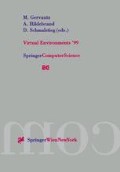Abstract
Multi-user augmented reality requires excellent registration for all users, which cannot be achieved by magnetic trackers alone. This paper presents a new approach combining magnetic and optical tracking. The magnetic tracker is used to coarsely predict the positions of landmarks in the camera image. This restricts the search area to a size which can be managed close to real-time. This new hybrid tracking system outperforms a calibrated magnetic tracker in terms of position, orientation, and jitter.
Access this chapter
Tax calculation will be finalised at checkout
Purchases are for personal use only
Preview
Unable to display preview. Download preview PDF.
References
Ronald Azuma and Gary Bishop. Improving static and dynamic registration in an optical see-Through HMD. In Proceedings of SIGGRAPH’94, Orlando, Florida, pages 197–204, July 1994.
S. Brantner. A vision-based tracking technique for augmented reality. Master’s thesis, Computer Graphics and Vision, Graz University of Technology, Miinzgrabenstr. 11, 8010 Graz, Austria, 1998. ftp://ftp.icg.tugraz.ac.at/pub/publications/tom/papers/brantner.ps.gz.
M. A. Fischler and R. C. Bolles. Random sample consensus: a paradigm for model fitting with applications to image analysis and automated cartography. Communications of the ACM, 24 (6): 381–395, June 1981.
M. Gervautz, D. Schmalstieg, Z. Szalavâri, K. Karner, F. Madritsch, and A. Pinz. “Studierstube” – A multi–user augmented reality environment for visualization and education. Technical report TR–186–2–96–10, Institute of Computer Graphics, Technical University Vienna, 1996.
G.D. Hager and K. Toyama. Xvision: A portable substrate for real-time vision applications. Computer Vision and Image Understanding, 69 (1): 23–37, January 1998.
W.A. Hoff, T. Lyon, and K. Nguyen. Computer-vision-based registration techniques for augmented reality. In Intelligent Robots and Computer Vision XV, Boston, pages 538–548, November 1996.
M.A. Livingston and A. State. Magnetic tracker calibration for improved augmented reality registration. Technical report, Department of Computer Science, University of North Carolina - Chapel Hill, January 1996.
David G. Lowe. Three-dimensional object recognition from single two-dimensional images. Artifical Intelligence, pages 355–395, 1987.
A. State, G. Hirota, D.T. Chen, W.F. Garrett, and M.A. Livingston. Superior augmented reality registration by integrating landmark tracking and magnetic tracking. In Proceedings of SIGGRAPH’96, New Orleans, Louisiana, pages 429–438. ACM SIGGRAPH, August 4–9 1996.
J. Steinwendner and W. Schneider. Algorithmic improvements in spatial subpixel analysis of remote sensing images. In Pattern Recognition and Medical Computer Vision, 22nd Workshop of the Austrian Association for Pattern Recognition, pages 205–214, May 1998.
Author information
Authors and Affiliations
Editor information
Editors and Affiliations
Rights and permissions
Copyright information
© 1999 Springer-Verlag/Wien
About this paper
Cite this paper
Auer, T., Brantner, S., Pinz, A. (1999). The integration of optical and magnetic tracking for multi-user augmented reality. In: Gervautz, M., Schmalstieg, D., Hildebrand, A. (eds) Virtual Environments ’99. Eurographics. Springer, Vienna. https://doi.org/10.1007/978-3-7091-6805-9_5
Download citation
DOI: https://doi.org/10.1007/978-3-7091-6805-9_5
Publisher Name: Springer, Vienna
Print ISBN: 978-3-211-83347-6
Online ISBN: 978-3-7091-6805-9
eBook Packages: Springer Book Archive

